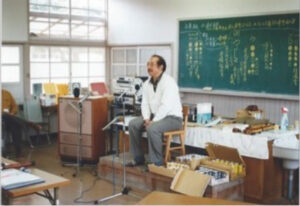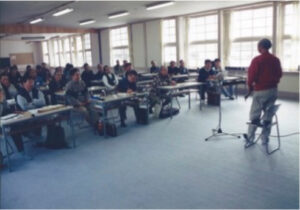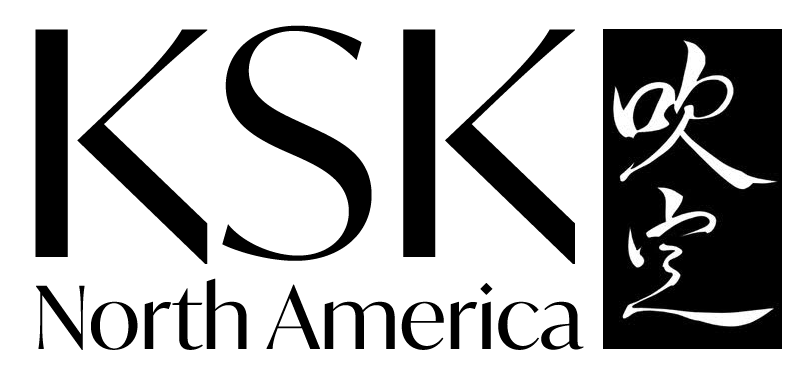The History of the KSK

Secondly, Yokoyama Sensei was committed to finding an increasingly large space for the shakuhachi on the world stage. To that end, he was something of a shakuhachi ambassador who devoted a very large part of his professional life to sharing the instrument and its music in as many different countries as he could. And in this effort he had been quite successful.
Thirdly, he strove to unite the shakuhachi community in Japan. Although he was known and very much appreciated for producing the first World Shakuhachi Festival at the KSK training center in Bisei in 1994 – which brought many Japanese players together who had long been divided by their separate lineages and traditions – he had actually begun to work toward that goal many years earlier when he performed and recorded with shakuhachi masters from other lineages such as Aoki Reibo and Yamamoto Hozan.
The original vision for the establishment of the KSK came from an experience Yokoyama Sensei had while playing with the world-renowned taiko group ‘Kodo’ at their residential training facility on Sado Island. While visiting there, he was apparently quite impressed with Kodo’s approach of combining musical training with the development of a lifestyle which included a regimen of daily physical exercise as well as participation in the general maintenance of Kodo Village. His thought was that this comprehensive approach to musical development could be applied to shakuhachi training as well, so that his original vision for KSK was that it would be a residential training facility, and in particular a shakuhachi vegetable farm of sorts open to any student of any nationality who was interested in committing themselves to the development of a full shakuhachi way of life.
In certain respects, this initial vision for the KSK paralleled monastic training in which a student might divide his or her time among several pursuits:  primary instruction or training in Zazen for example (or playing Honkyoku in the case of the KSK), growing vegetables, and otherwise helping to look after the residential community. The appropriate venue for such a program was of critical importance of course, and Yokoyama’s initial step in realizing his vision was to find a building in which to house his training center. After a lengthy search, he signed a lease on a vacated high school in Bisei, in the mountains above Okayama. This was a space that included ample residential facilities for live-in students and had plenty of training space, and which at that time included adjacent land for vegetable farming. In all, it was a promising location.
primary instruction or training in Zazen for example (or playing Honkyoku in the case of the KSK), growing vegetables, and otherwise helping to look after the residential community. The appropriate venue for such a program was of critical importance of course, and Yokoyama’s initial step in realizing his vision was to find a building in which to house his training center. After a lengthy search, he signed a lease on a vacated high school in Bisei, in the mountains above Okayama. This was a space that included ample residential facilities for live-in students and had plenty of training space, and which at that time included adjacent land for vegetable farming. In all, it was a promising location.
In fact however, the KSK training center got off to a slow start and never quite materialized in the way Yokoyama Sensei had in envisioned. Despite his initial enthusiasm about his plan (he had even bought a part time residence for himself and his wife just down the hill from the training center), and in spite of the fact that he was a sought after teacher who was genuinely welcoming of any student who wanted to come train in Bisei, the administrative burdens associated with establishing and maintaining such a residential training facility proved to be insurmountable. Moreover, developing his personal philosophy of playing shakuhachi – to make a better sound, expand shakuhachi to the world, and emphasize the honkyoku that unites us over the Ryu traditions that divide us — into a detailed teaching curriculum while also developing the administrative infrastructure needed to make and keep a school also ended up being too much to take on. It was not possible to simultaneously be the head of the school, its chief instructor, and an active composer and performer who had dedicated his life to spreading shakuhachi music around the world.
 This does not mean however that students were not training in Bisei in these early years. There were many Japanese students who attended workshops and individual lessons there on a regular basis, and even quite a few foreign students. And of course, the campus provided the venue for the first World Shakuhachi Festival as noted above, conceived by Yokoyama and produced by him and his students in 1994. And since those early days, study at the training center in Bisei has been ongoing, just not quite in the way that Yokoyama Sensei had initially foreseen it. Under the very capable leadership of his principal disciples, including Mr. Furuya, Mr. Matama and Mr. Kakizakai, the KSK continues to hold twice yearly extended workshops in two different locations, the Mitsu Minne Shinto shrine near Chichibu in Saitama Prefecture and at the Bisei training facility. They also teach and perform worldwide, make recordings, and in broad terms, safeguard the Yokoyama legacy. So that overall, the Kenshukan has endured with a strong reputation.
This does not mean however that students were not training in Bisei in these early years. There were many Japanese students who attended workshops and individual lessons there on a regular basis, and even quite a few foreign students. And of course, the campus provided the venue for the first World Shakuhachi Festival as noted above, conceived by Yokoyama and produced by him and his students in 1994. And since those early days, study at the training center in Bisei has been ongoing, just not quite in the way that Yokoyama Sensei had initially foreseen it. Under the very capable leadership of his principal disciples, including Mr. Furuya, Mr. Matama and Mr. Kakizakai, the KSK continues to hold twice yearly extended workshops in two different locations, the Mitsu Minne Shinto shrine near Chichibu in Saitama Prefecture and at the Bisei training facility. They also teach and perform worldwide, make recordings, and in broad terms, safeguard the Yokoyama legacy. So that overall, the Kenshukan has endured with a strong reputation.
